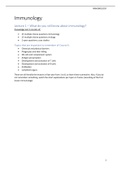IMMUNOLOGY
Immunology
Lecture 1 – What do you still know about immunology?
Knowledge test 2 consists of:
• 25 multiple choice questions immunology
• 25 multiple choice questions virology
• 2 open questions; case studies
Topics that are important to remember of Course 6:
• Chemical and physical barriers
• Phagocytes and their killing
• NK cells and complement system
• Antigen presentation
• Development and activation of T cells
• Development and activation of B cells
• Antibodies
• Lymphoid organs
These are all literally the lectures of last year from 1 to 8, so learn these summaries. Also, if you do
not remember something, watch the short explanations per topic on Teams (recording of the first
lesson immunology).
1
, IMMUNOLOGY
Lecture 2 – Immunity against bacteria
Defense against bacteria
All the barriers of the human body.
Content of this lecture:
What is important for a bacterial infection?
Which proteins are involved in a bacterial infection?
Innate immune: system which cells are mainly involved?
Adaptive immune: which cells are mainly involved?
Summary – immunity to bacteria
• Physical barriers
• Complement system
• Recognition PRRs
• Phagocytosis
• T cells
• Antibodies
Case study (open question)
• How does a case study work?
o Bacterium X / Virus Y enters body at place Z.
o What happens?
o Describe, as detailed as possible, the “chronological order” of the events of your
immune system.
Link video (short summary of phagocytes): …
First line of defence:
• Physical barriers
o E.g. antimicrobial proteins on the skin, lysozyme or defensins, multi-layered
epithelium, tight junctions.
o Skin itself is NO physical barrier, because there are layers ON the skin which are the
barriers.
• Chemical barriers
2
, IMMUNOLOGY
Complement system
The pathways:
• Classical
• Alternative
• Lectin
• (+ terminal)
The most important protein in the pathway: C3
3 different functions of the pathways:
• Lytic / membrane attack complex, (C5-C9)
• Chemotaxix, C5a/C3a attracts immune cells
• Opsonization, by breakdown product of C3
3
, IMMUNOLOGY
Question: the classical pathway occurs from day 1 after infection with new bacteria: true/false.
Answer: False, the classical pathway involves antibodies, and the adaptive immune system needs
time to get activated. Because it is new bacteria, there are no antibodies made for it yet. It IS possible
for the lectin and alternative pathway.
Second line of defence
Innate immune system
• Phagocytes (main cells involved in the innate immune system)
o How do phagocytes recognize bacteria?:
o Recognition: Pathogen Associated Molecular Patterns (PAMPs)
o Recognized by: pattern recognition receptors
• Innate lymphoid cells (ILC)
o Classic lymphoid cells but lack rearranged antigen-specific receptors, that is why they
are innate.
o Present in barrier tissues (e.g. skin, intestine, lung); everywhere where bacteria can
enter the body.
o ILC-1, ILC-2, ILC-3
▪ ILC1 (intracellular bacteria): secrete IFNy
• IFNy enhances macrophage function
▪ ILC3: secrete IL17 and IL22
• IL17: induces stromal cells to secrete chemokines, which attract
neutrophils (and monocytes)
• IL22: induces epithelial cells to secrete antimicrobial peptides.
Question: Which long-living phagocyte is present in tissue?
Answer: Macrophages are present in tissues, while monocytes are present in blood. They are both
long-living. Neutrophils are short-living.
Phagocytes
• Macrophages
o In tissue, long-living, first at the infection site
• Monocytes
o In blood, long-living, “classical” and “patrolling”
• Neutrophils
o In blood, short-living, attracted to site of infection
4






